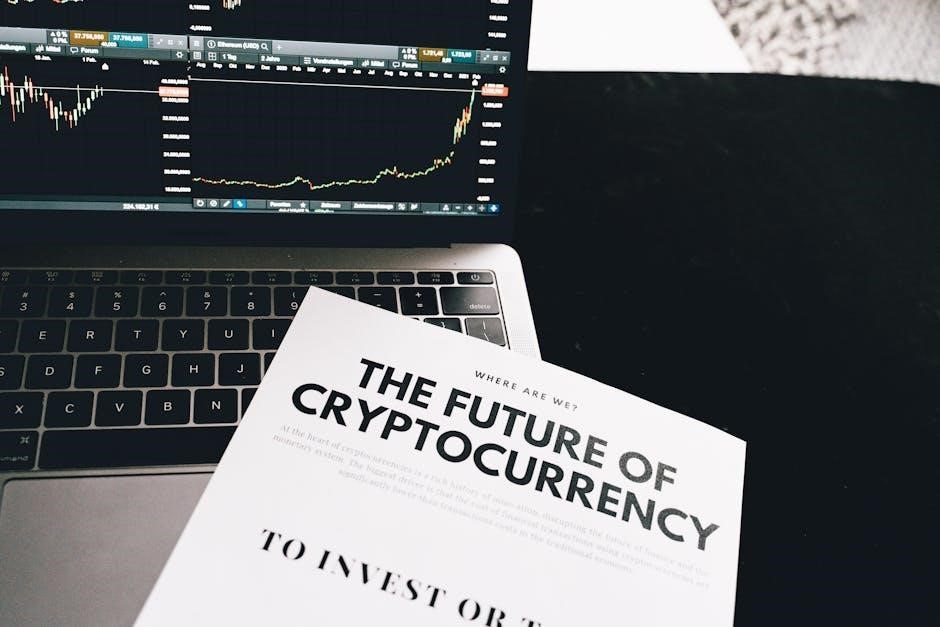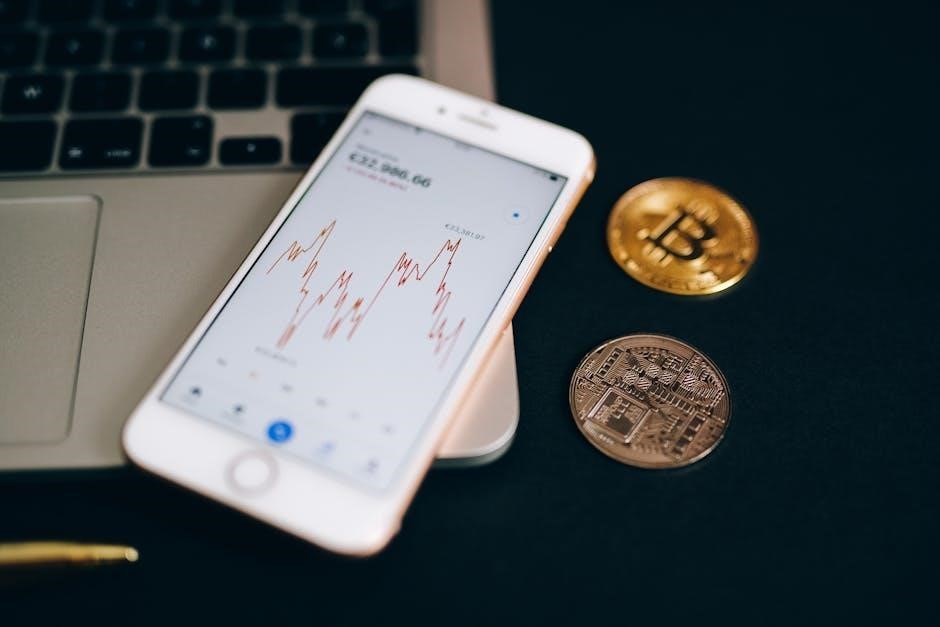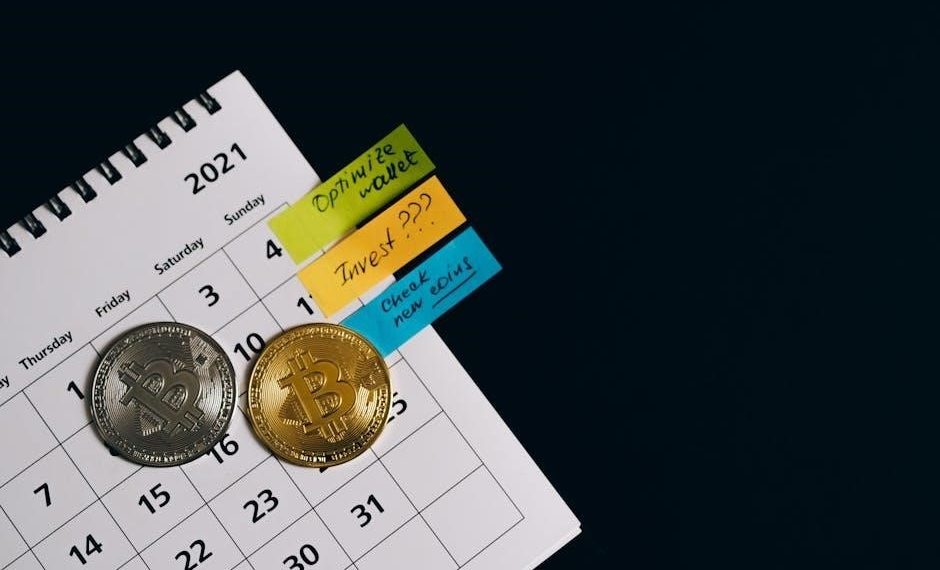a complete guide to the futures markets
Futures markets enable traders to buy or sell assets at predetermined prices and dates, offering a platform for hedging and speculation with high liquidity and transparency.

What Are Futures Contracts?
Futures contracts are standardized agreements to buy or sell an asset at a predetermined price and date, enabling hedging or speculation in financial markets.
2.1 Definition and Purpose
Futures contracts are standardized agreements to buy or sell an asset at a predetermined price and date. They are derivatives, deriving value from underlying assets like commodities, stocks, or currencies. The primary purpose of futures contracts is to provide a platform for hedging against price risks and enabling speculation on price movements. Hedgers use them to lock in prices and manage risk, while speculators aim to profit from price fluctuations. Futures contracts are traded on exchanges, ensuring transparency and liquidity. They play a critical role in price discovery and risk management, making them essential tools in modern financial markets.
2.2 How Futures Contracts Work
Futures contracts are agreements between buyers and sellers to trade an asset at a fixed price on a specific future date. These contracts are standardized, meaning their terms, such as quantity and expiration, are predefined by exchanges. Trading occurs on regulated platforms like the Chicago Mercantile Exchange (CME), ensuring transparency and fairness. A clearing house acts as an intermediary, guaranteeing the fulfillment of contracts and managing margins to mitigate risks. Futures allow participants to hedge against price fluctuations or speculate on market movements. Traders must post margin deposits to maintain positions, enabling leveraged exposure to the market while managing potential losses effectively.
2.3 Key Features of Futures Contracts
Futures contracts are standardized agreements with predefined terms, including quantity, delivery dates, and asset specifications. They are traded on regulated exchanges, ensuring transparency and fair pricing. Margin requirements allow traders to leverage positions, amplifying potential gains and risks. Contracts are marked-to-market daily, adjusting account balances based on price movements. A clearing house guarantees contract fulfillment, reducing counterparty risk. Futures markets operate with high liquidity, enabling efficient entry and exit from positions. These features make futures contracts versatile tools for hedging, speculation, and risk management, appealing to a wide range of market participants seeking exposure to various asset classes.

The Role of the Clearing House
The clearing house acts as a central counterparty, ensuring the integrity of futures transactions. It guarantees contract fulfillment by intermediating between buyers and sellers, eliminating counterparty risk. The clearing house manages margin requirements, holding funds to cover potential losses. It also facilitates daily mark-to-market settlements, adjusting account balances based on price changes. Additionally, the clearing house oversees trade confirmation, delivery processes, and dispute resolution. By providing a secure and regulated environment, the clearing house enhances market efficiency and trust, enabling smooth trading operations. Its role is critical in maintaining the stability and functionality of futures markets globally.
Participants in Futures Markets
Futures markets attract hedgers, speculators, and arbitrageurs, each with distinct strategies, contributing to market liquidity and efficiency while managing risk or capitalizing on price movements.
4.1 Hedgers
Hedgers use futures contracts to manage price risks associated with their assets or liabilities. For example, airlines might hedge against fuel price increases by locking in future costs. Farmers can protect against crop price declines by selling futures contracts. Hedging strategies allow these market participants to reduce financial uncertainty, ensuring stability in their operations. By taking offsetting positions in futures markets, hedgers can mitigate potential losses and secure profitable prices, making it a vital tool for risk management in commodities, currencies, and other assets.
4.2 Speculators
Speculators in futures markets aim to profit from price fluctuations by taking calculated risks. Unlike hedgers, they do not hold underlying assets but instead speculate on future price movements. They can take long positions (expecting prices to rise) or short positions (anticipating price declines). Speculators rely on market analysis, technical indicators, and economic trends to make informed decisions. Leverage allows them to control larger positions with less capital, amplifying potential gains—and risks. Successful speculators thrive by accurately predicting market trends, contributing to market liquidity and price discovery while seeking substantial returns in volatile markets.
4.3 Arbitrageurs
Arbitrageurs exploit price differences between related markets or instruments to generate risk-free profits. They identify misalignments in pricing and execute trades to capitalize on these inefficiencies. For instance, arbitrageurs might buy a futures contract at a lower price and simultaneously sell it in a different market at a higher price. This activity helps to create market equilibrium by driving prices toward convergence. Arbitrageurs play a crucial role in ensuring market efficiency and liquidity, contributing to the smooth functioning of futures markets. Their strategies require rapid execution and precise analysis, making them essential participants in maintaining balanced and orderly trading environments.
Advantages and Risks of Futures Trading
Futures trading offers significant advantages, including high liquidity, leverage, and the ability to hedge against price risks. Traders can amplify potential gains through margin requirements, allowing for larger positions with less capital. Additionally, futures provide opportunities to profit from both rising and falling markets by taking long or short positions. However, these benefits come with substantial risks. Market volatility can lead to rapid price swings, and leverage amplifies losses as well as gains. Traders must also manage margin calls and the potential for large financial exposure. The complexity of futures contracts and the need for precise market timing further increase the risk, making it essential for participants to employ robust risk management strategies to mitigate potential downsides.
Popular Futures Markets
Popular futures markets include crude oil, gold, E-mini S&P 500, Euro FX, and Bitcoin futures, offering diverse opportunities for traders to engage in high-liquidity markets globally.
6.1 Commodities Futures
Commodities futures are contracts to buy or sell physical assets like crude oil, gold, and agricultural products at a set price and date. These markets attract hedgers and speculators alike, offering high liquidity and volatility. Crude oil futures are particularly popular due to their global demand and geopolitical influences. Gold futures, often seen as a safe-haven asset, are widely traded during economic uncertainties. Agricultural commodities like wheat and corn also feature prominently, allowing farmers and producers to hedge against price fluctuations. Bitcoin futures have recently emerged, enabling traders to gain exposure to cryptocurrency without direct ownership. These contracts are standardized, traded on major exchanges, and provide a transparent way to speculate on commodity prices, making them a cornerstone of global markets.
6.2 Financial Futures
Financial futures are contracts to buy or sell financial instruments at a predetermined price and date. These include index futures, interest rate futures, and currency futures. The E-mini S&P 500 and Euro FX futures are popular examples, offering high liquidity and volatility. These contracts allow traders to speculate on market movements or hedge against financial risks. Index futures enable exposure to broad market indices, while interest rate futures help manage risk associated with changes in borrowing costs. Currency futures reflect exchange rate fluctuations, making them ideal for forex traders. Financial futures provide a platform for both institutional and individual traders to manage risk and capitalize on market opportunities effectively.
6.3 Currency Futures
Currency futures are standardized contracts to buy or sell currencies at a set price and date. They allow traders to hedge against exchange rate risks or speculate on currency fluctuations. Unlike spot forex, currency futures are traded on exchanges, ensuring transparency and regulation. Popular contracts include Euro FX futures, which track the euro’s value against the U.S. dollar. These instruments are widely used by corporations and investors to manage foreign exchange exposure. Currency futures provide a platform to capitalize on global economic trends and interest rate differentials. Their standardized nature ensures uniform contract sizes and expiration dates, making them accessible for diverse trading strategies and risk management needs.

How to Get Started with Futures Trading
To begin futures trading, open a futures trading account with a licensed broker, ensuring they offer the markets you’re interested in. Familiarize yourself with the basics of futures contracts, margin requirements, and leverage. Conduct thorough market research and analyze trends using technical and fundamental analysis. Develop a trading plan with clear goals, risk tolerance, and strategies. Start with small positions to gain experience and gradually scale as confidence grows. Stay updated with market news, economic indicators, and geopolitical events that may impact prices. Consider using trading platforms with demo accounts to practice before committing real capital. Continuous education and discipline are key to navigating the high-risk, high-reward world of futures trading successfully.
Risk Management in Futures Trading
Risk management is crucial in futures trading due to its high leverage and volatility. Start by setting clear risk tolerance levels and implementing stop-loss orders to limit potential losses. Diversify your portfolio across different asset classes to reduce exposure to market-specific risks. Use position sizing strategies to avoid over-leveraging and ensure each trade aligns with your overall risk profile. Hedging techniques, such as options strategies, can also mitigate downside risks. Regularly monitor and adjust your strategies to adapt to market conditions. Maintain disciplined adherence to your trading plan and avoid emotional decision-making. Finally, stay informed about economic trends and geopolitical events that could impact your trades.

Current Trends in Futures Markets
Current trends in futures markets reflect evolving investor preferences and technological advancements. Increased adoption of automated trading systems and AI-driven strategies is reshaping how traders approach the markets. Cryptocurrency futures, such as Bitcoin and Ethereum, are gaining traction due to the growing popularity of digital assets. Additionally, there is a rise in demand for ESG (Environmental, Social, and Governance)-compliant futures contracts, aligning with global sustainability goals. Geopolitical uncertainties, such as energy supply disruptions, are also influencing futures markets, particularly in commodities like oil and natural gas. Furthermore, advancements in trading platforms are making futures markets more accessible to retail investors, fostering greater market participation and diversity.
Futures markets remain a cornerstone of global finance, offering unparalleled opportunities for risk management and speculation. As technology advances, automated trading and AI-driven strategies are reshaping the landscape. The rise of cryptocurrency futures, such as Bitcoin and Ethereum, highlights the markets’ adaptability to emerging assets. ESG-compliant futures are also gaining traction, reflecting global sustainability trends. Geopolitical uncertainties and commodity price volatility ensure futures markets will continue to play a critical role in managing risk. The future outlook is promising, with increasing accessibility for retail investors and innovations in trading platforms. Staying informed and adaptable will be key to navigating this dynamic financial arena effectively.
